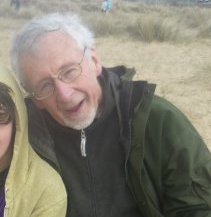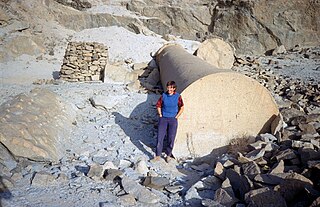
Paleoethnobotany, or archaeobotany, is the study of past human-plant interactions through the recovery and analysis of ancient plant remains. Both terms are synonymous, though paleoethnobotany is generally used in North America and acknowledges the contribution that ethnographic studies have made towards our current understanding of ancient plant exploitation practices, while the term archaeobotany is preferred in Europe and emphasizes the discipline's role within archaeology.

Anshan modern Tall-e Malyan, also Tall-i Malyan, was an Elamite and ancient Persian city. It was located in the Zagros Mountains in southwestern Iran, approximately 46 kilometres (29 mi) north of Shiraz and 43 kilometres (27 mi) west of Persepolis in the Beyza/Ramjerd plain, in the province of Fars.

Roman gardens and ornamental horticulture became highly developed under Roman civilization, and thrived from 150 BC to 350 AD. The Gardens of Lucullus, on the Pincian Hill in Rome, introduced the Persian garden to Europe around 60 BC. It was seen as a place of peace and tranquillity, a refuge from urban life, and a place filled with religious and symbolic meaning. As Roman culture developed and became increasingly influenced by foreign civilizations, the use of gardens expanded.

Gordon Hillman was a British archaeobotanist and academic at the UCL Institute of Archaeology. He has been described as "a pivotal figure in the development of archaeobotany at the Institute of Archaeology at University College London, [who] through his research, publications and teaching had a major influence on the field worldwide."
Kristen Johnson Gremillion is an American anthropologist whose areas of specialization include paleoethnobotany, origins of agriculture, the prehistory of eastern North America, human paleoecology and paleodiet, and the evolutionary theory. Currently a professor in the Department of Anthropology at the Ohio State University and editor of the Journal of Ethnobiology, she has published many journal articles on these subjects.

In archaeology, a biofact is any organic material including flora or fauna material found at an archaeological site that has not been technologically altered by humans yet still has cultural relevance. Biofacts can include but are not limited to plants, seeds, pollen, animal bones, insects, fish bones and mollusks. The study of biofacts, alongside other archaeological remains such as artifacts are a key element to understanding how past societies interacted with their surrounding environment and with each other. Biofacts also play a role in helping archaeologists understand questions of subsistence and reveals information about the domestication of certain plant species and animals which demonstrates, for example, the transition from a hunter-gatherer society to a farming society.

Kamyar Abdi is an Iranian anthropologist and professor of Near Eastern archaeology at Shahid Beheshti University. After studying theoretical physics for a year, he began his undergraduate studies in archaeology at Tehran University, leading to a master's degree. Afterwards, he enrolled in the Oriental Institute of the University of Chicago in 1994 to study Near Eastern archaeology, history, and languages. Abdi received his PhD in Anthropological Archaeology from the University of Michigan in 2002, under the supervision of Henry T. Wright. Prior to joining the Shahid Beheshti University in Tehran, he taught and researched in many institutions, namely Dartmouth College, Harvard University, University of California, Irvine and the British Museum. He was a research associate at the Iranian Center for Research on Humanities and Cultural Studies. In addition to many editorial memberships in national and international journals, Abdi has been affiliated with national and international councils and associations, as well as executive experiences such as directing the American Institute of Iranian Studies. Abdi has carried out many archaeological surveys and excavations in Iran, financially supported by domestic and international organizations, including the NSF, NGS, AllS, and lCAR. The outcomes of his research have played an outstanding role in assisting the scientific community with resolving many questions pertinent to Near Eastern archaeology from prehistory and the Bronze Age to the Achaemenid period. He has also participated in archaeological field projects in Turkey, lraq, US, Mexico, and Guatemala. Abdi has published many articles and books in English and Persian, and has translated a large number of books and articles from Western languages into Persian. In the meantime, he continues to train undergraduate and graduate students and supervise graduate student thesis and dissertations.

Gordion was the capital city of ancient Phrygia. It was located at the site of modern Yassıhüyük, about 70–80 km (43–50 mi) southwest of Ankara, in the immediate vicinity of Polatlı district. Gordion's location at the confluence of the Sakarya and Porsuk rivers gave it a strategic location with control over fertile land. Gordion lies where the ancient road between Lydia and Assyria/Babylonia crossed the Sangarius river. Occupation at the site is attested from the Early Bronze Age continuously until the 4th century CE and again in the 13th and 14th centuries CE. The Citadel Mound at Gordion is approximately 13.5 hectares in size, and at its height habitation extended beyond this in an area approximately 100 hectares in size. Gordion is the type site of Phrygian civilization, and its well-preserved destruction level of c. 800 BCE is a chronological linchpin in the region. The long tradition of tumuli at the site is an important record of elite monumentality and burial practice during the Iron Age.

Bolboschoenus is a genus of plants in the sedge family, of nearly cosmopolitan distribution. Epipaleolithic and Neolithic peoples used ground root tubers of these plants to make the first breads.
The Graduate Group in the Art and Archaeology of the Mediterranean World (AAMW) is an interdisciplinary program for research and teaching of archaeology, particularly archaeology and art of the ancient Mediterranean, Egypt, Anatolia, and the Near East, based in the Penn Museum of the University of Pennsylvania.
Klaus Oeggl is a retired Austrian botanist, and deals with palaeoecology and archaeobotany. He is well known for his studies on the life-circumstances and on the environment of the Neolithic glacier mummy "Ötzi".
George Willcox is an archaeobotanist who specialises in the origins of agriculture in the Near East. He has been employed as researcher with the CNRS France since 1989. He has dual French and British nationality. He studied environmental archaeology under the late Prof. Dimbleby at the Institute of Archaeology in London during the early 1970s and was then employed as environmental archaeologist by the Museum of London. In 1977 he married and left his job to follow his interest in Near Eastern archaeobotany. An interest which he had acquired as an undergraduate working with Gordon Hillman in Turkey. During the next few years he worked in Turkey, Afghanistan Jordan, Oman, Kuwait, Tajikistan, India and Syria and started amassing a charred archaeobotanical collection and modern reference collection. These are now housed at the Muséum national d’Histoire naturelle in Paris. It was during this somewhat precarious period that he moved to France and founded a family. In 1984 Gordon Hillman introduced George to Jacques Cauvin and Patrica Anderson at the CNRS Institut de Préhistore Orientale in south east France where they developed a project on experimentally cultivating wild cereals In 1989 George entered the CNRS working on a number of early Neolithic sites in Syria in particular with Danielle Stordeur at Jerf el Amhar. He lectured at several French universities on archaeobotany and the origins of agriculture and supervised post graduate students. He was an associate editor for Vegetation History and Archaeobotany for many years and received an honorary doctorate from the University of Basel in 2013. His 117 scholarly publications are a measure of his research achievements. In 2014 with statutory retirement the CNRS awarded George the status of "Directeur de Recherche Emérite, CNRS" which allows him to continue to supervise students, sit on PhD panels, peer review manuscripts and carry out field work.
Glynis Eleanor Jones FBA is a British archaeobotanist, who is Professor of Archaeology at the University of Sheffield.

Marijke van der Veen, is a Dutch archaeobotanist and Emeritus Professor of Archaeology at the University of Leicester.
Stefanie Jacomet is professor of archaeobotany at Basel University. Her research focuses on investigating wetland sites in Central Europe and developing archaeobotanical methodologies.
The International Work Group for Palaeoethnobotany (IWGP) is an informal, international collective of archaeobotanists, with the main goal of establishing and maintaining international communication and collaboration by a series of conferences. These conferences focus mainly, but not exclusively, on the study of plant macrofossils in order to reconstruct past subsistence, trade, construction, ritual, and the environment.
Maria Hopf was a pioneering archaeobotanist, based at the RGZM, Mainz.

Lisa Ann Lodwick was a British archaeologist who studied charred, mineralised and waterlogged macroscopic plant remains, and used carbon and nitrogen stable isotope analysis to understand the crop husbandry practices of the ancient Romans.
Udelgard Körber-Grohne was a German archaeobotanist.
The paleoethnobotany of the Mapuche focuses on archaeological evidence supporting plant use by past and present Mapuche populations collected from multiple sites in southern Chile and the Patagonia region of Argentina. Paleoethnobotany is the study of fossil and material remains from plants, mostly seeds and residues that can be analyzed from material remains. Data can be collected from archaeological sites with a particular interest in learning about the history of agriculture in a region or the use of plants for either subsistence or medicinal use. The Mapuche are an indigenous culture native to South America. The archaeological record has revealed that the Mapuche were present in modern-day south-central Chile and southwestern Argentina from at least 500-600 BC. It is also noteworthy, that while collectively the Mapuche use this endonym, there are often subsets of the culture that have more specific names based on geographic location as well as different ecological niches.










